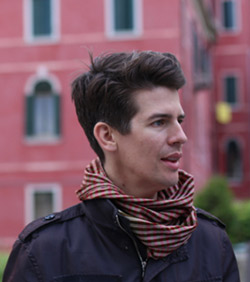Filed Under > Views on the News
Positive Transformations: Fulbright Fellow Nathanael J. Andreini (M.A. '14) blogs from Slovenia
I spent two years at TC contextualizing my decade-long background as a socially engaged artist with the transformation I experienced in Japan. During my first year, I got involved with the Consortium for Japan Relief – a group composed of students and faculty members across Columbia University. We organized interdisciplinary symposia, lectures, and documentary screenings to bring artists, filmmakers, journalists, architects, and doctors together to discuss the challenges and innovations taking place in the affected regions of Japan.
While developing my thesis project and working at the Advanced Consortium on Cooperation, Conflict, and Complexity (AC4) at the Earth Institute, I began to research various models used to overcome conflicts. My thesis project entitled, Beyond Disaster Relief: Socially Engaged Art and the Great East Japan Earthquake, investigated how emerging networks of contemporary artists, educators, and activists “perform” an informal brand of humanitarian response through projects that emphasize social action, participation, and civic engagement. It was during this research that I discovered the Museum of Transitory Art (MoTA) in Ljubljana, Slovenia – the site of my current Fulbright. This discovery expanded my interest in adaptable and resilient individuals living in destabilized conditions to include communities and organizations, as well.
MoTA does not maintain a permanent physical space. Instead, it is a set of educational and curatorial initiatives that showcase emerging and experimental forms of production: socially engaged art, live art, sound art, and collaborative art, which are realized in different locations, artist exchange programs, and other contexts throughout Slovenia and the Balkans. At MoTA, education, public programming, and curatorial practices have been structurally combined as a direct attempt to deconstruct institutional and disciplinary silos. Thus, each participating artist, researcher, and partnering organization is perceived as an equal collaborator. In this way, MoTA provides a unique and adaptable model of how an institution can be configured in opposition to mainstream hierarchical norms in order to satisfy the needs of a broader community.
My research will take place in four stages. First, I am focusing on gathering data through in-depth interviews with MoTA’s co-directors. Second, I will begin mapping the museum’s organizational blueprint and continue to interview extended staff members and selected visitors about the access and efficacy the museum’s programs. These interviews will be key in understanding how the organizational configuration at MoTA can be adapted to benefit defective structures elsewhere. Third, I plan to engage with MoTA’s many collaborators – fellow artists, researchers, and partner organizations. These interactions will be a series of interviews and observations, some of which will take form as studio visits with selected artists. And finally, as MoTA’s artist-in-residence, I will collaborate with the local community on a project connecting the research with practice during the summer of 2015.
I am extremely thankful for the opportunities I had at TC to explore these topics as a graduate student. I have benefited greatly from interactions and courses with exceptional faculty members, especially Maxine Greene, Hope Leichter, Tamar Rapoport, Morton Deutsch, and Peter T. Coleman.
Published Tuesday, Oct. 14, 2014
